351st Infantry Regiment (United States)
The 351st Infantry Regiment was a National Army Infantry Regiment first organized for service in World War I as part of the 88th Infantry Division in Europe. It later served in the Mediterranean Theater during World War II. Since then it has served as a training Regiment, training Army Reserve and Army National Guard Soldiers for service in support of the Global War on Terror.[1][2]
| 351st Infantry Regiment | |
|---|---|
 Regimental Distinctive Unit Insignia | |
| Active | 1917–1919 1921–1945 1946–present |
| Country | |
| Branch | U.S. Army |
| Role | Infantry |
| Size | Regiment |
| Part of | First Army |
| Motto(s) | TOUJOURS PRÊT (Always Ready) |
| Colors | Blue and Silver |
| Anniversaries | Constituted 5 August 1917 in the National Army |
| Decorations | Croix de Guerre, Army Superior Unit Award |
| Battle honours | World War I World War II |
U.S. Infantry Regiments | |
|---|---|
| Previous | Next |
| 350th Infantry Regiment | 352nd Infantry Regiment |
Service history
World War I
The Regiment was constituted 5 August 1917 in the National Army as the 351st Infantry and assigned to the 176th Infantry Brigade of the 88th Division. It was organized at Camp Dodge, Iowa on 30 August 1917, and Herbert B. Crosby was named to command it. In August 1917, the Regiment was organized with 3,755 Officers and enlisted men:
- Headquarters & Headquarters Company- 303
- Supply Company- 140
- Machine Gun Company- 178
- Medical & Chaplain Detachment- 56
- Infantry Battalion (x3)- 1,026
- Headquarters- 2
- Rifle Company (x4)- 256[3]
The Doughboys of the Regiment deployed to France as part of the American Expeditionary Forces .[4][5][6] After completing its war service in France it demobilized at Camp Dodge on 7 June 1919.[7]
Between the Wars
The Regiment was reconstituted in the Organized Reserves as the 351st Infantry on 24 June 1921 and reassigned to the 88th Division (later redesignated as the 88th Infantry Division) in the Sixth Corps Area.[9][10]
World War II
The Regiment was ordered into active military service 15 July 1942 and reorganized at Camp Gruber, Oklahoma using a cadre provided by the 9th Infantry Division.[11] The Regiment participated in the Louisiana Maneuvers in June through August 1943. The Regiment departed Camp Patrick Henry on 4 November 1943 through the Hampton Roads Port of Embarkation as Shipment 8629-H. In July 1943, the Regiment was organized with 3,256 Officers and enlisted men:[12]
- Headquarters & Headquarters Company- 111
- Service Company- 114
- Anti-Tank Company- 165
- Cannon Company- 118
- Medical Detachment- 135
- Infantry Battalion (x3)- 871
- Headquarters & Headquarters Company- 126
- Rifle Company (x3)- 193
- Weapons Company- 156
 Hampton Roads Port of Embarkation
Hampton Roads Port of Embarkation Welcome Home, Camp Patrick Henry
Welcome Home, Camp Patrick Henry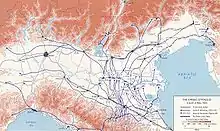 Spring Offensive, Italy 1945
Spring Offensive, Italy 1945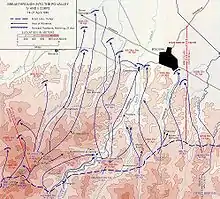 IV Corps operations, Italy April 1945
IV Corps operations, Italy April 1945
Trieste United States Troops
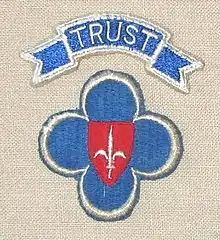
The 351st Infantry was relieved from assignment to the division on 1 May 1947 and served as temporary military Government of the Free Territory of Trieste, securing the new independent State[14] between Italy and Yugoslavia on behalf of the United Nations Security Council.[15] Designated TRUST (Trieste United States Troops), the command served as the front line in the Cold War from 1947 to 1954, including confrontations with Yugoslavian forces. In October 1954 the mission ended upon the signing of the Memorandum of Understanding of London [16] establishing a temporary civil administration in the Anglo-American Zone of the Free Territory of Trieste, entrusted to the responsibility of the Italian Government.[17] TRUST units, which included a number of 88th divisional support units, all bore a unit patch which was the coat of arms of the Free Territory of Trieste superimposed over the divisional quatrefoil, over which was a blue scroll containing the designation "TRUST" in white. The 1948 organization of the Regiment called for a strength of 3,774 Officers and enlisted men organized as below:
- Headquarters & Headquarters Company- 289
- Service Company- 186
- Tank Company- 148
- Heavy Mortar Company- 190
- Medical Company- 214
- Infantry Battalion (x3)
- Headquarters & Headquarters Company- 119
- Rifle Company (x3)- 211
- Weapons Company- 165
Returning Home

The Regiment departed Leghorn, Italy on November 30, 1954 aboard the Military Sea Transportation Service USNS General Sturgis as shipment #19069-A. Returning to Camp Kilmer, New Jersey, the Regiment inactivated at Fort Rucker, Alabama on September 30, 1956. Personnel and equipment were used to reactivate the 99th Infantry Battalion of World War II fame. This unit was in turn inactivated on 24 March 1958 when the U.S. Army adopted the Pentomic force organization and the infantry unit at Fort Rucker was reorganized and reflagged as the 2d Battle Group, 31st Infantry, a unit organized for Aviation Center training support. When the U.S. Army reorganized into brigades and battalions in the early 1960s, the designation of 2-31st Infantry was reassigned to the 7th Infantry Division in Korea and the unit at Fort Rucker was reflagged as the 5th Battle Group, 31st Infantry. The 5-31st Infantry lineage, less personnel and equipment, was later reassigned to the 197th Infantry Brigade (Separate) at Fort Benning, Georgia, effective 23 June 1967 as the 5th Battalion, 31st Infantry; however, an infantry presence remained at Fort Rucker in the form of Company E (Ranger), 30th Infantry, activated on 25 August 1966 and later inactivated on 1 July 1978. Additionally, the Pathfinder Team, HHC, 2d Battle Group, 31st Infantry, formed in 1960, was reflagged as 5th Infantry Detachment (Pathfinder) effective 24 June 1963, and later expanded and reflagged as Company C (Pathfinder), 509th Infantry, activated effective 1 July 1975. C-509th was inactivated on 31 May 1993 and its personnel and equipment were reflagged as Company A (Pathfinder), 511th Infantry, and activated on 1 June 1993. A-511th was inactivated due to lowered budget ceilings on 31 October 1995, ending the post-war infantry presence at Fort Rucker that had begun with the 351st Infantry Regiment.
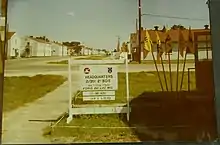
Under the 84th Training Division
The 351st Infantry was redesignated as the 351st Regiment, and reorganized to consist of the 1st, 2d, and 3d Battalions, elements of the 84th Division (Training) on 31 January 1968. On 16 September 1995, the Regimental Headquarters and the 3rd Battalion were inactivated.
Current Assignment
The 1st Battalion is a Regular Army Logistics unit assigned to the 181st Infantry Brigade at Fort McCoy, Wisconsin with a mission to train echelon above brigade Combat Sustainment Support Battalions and a Medical brigade.[19]
The 2nd Battalion is a Regular Army Infantry unit assigned to the 177th Armored Brigade at Camp Shelby, Mississippi with a mission to train infantry units of the National Guard.
The 3rd Battalion is a Regular Army Aviation unit assigned to the 166th Aviation Brigade at Fort Hood, Texas with a mission to train Aviation Battalions.[20]
Campaign streamers
| Conflict | Streamer | Year(s) |
|---|---|---|
| World War I |
Alsace | 1918 |
| World War II |
Rome-Arno[21] | 1944 |
| North Apennines[22] | 1944-1945 | |
| Po Valley[23] | 1945 |
Decorations
| Ribbon | Award | Embroidered | Year | Earned by |
|---|---|---|---|---|
| Presidential Unit Citation | MT. CAPELLO, ITALY | 1944 | 2nd Battalion | |
| Presidential Unit Citation | LAIATICO, ITALY | 1944 | 3rd Battalion | |
| Army Superior Unit Award | 2007-2008 | 2007-2008 | 1st Battalion | |
| Army Superior Unit Award | 2008-2011 | 2008-20011 | 1st and 2nd Battalions | |
| Croix de Guerre | Central Italy | 1944-1945 | Entire Regiment | |
| None | 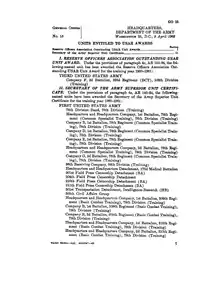 Secretary of the Army Superior Unit Certificate |
None | 1962 | Headquarters Company of 2nd Battalion |
Shoulder sleeve insignia

* Description: On a background equally divided horizontally white and red, 3¼ inches high and 2½ inches wide at base and 2⅛ inches wide at top, a black block letter "A", 2¾ inches high, 2 inches wide at base and 1⅝ inches wide at top, all members 7/16 inch wide, all enclosed within a 1/8 inch Army Green border.
- Symbolism:
- The red and white of the background are the colors used in flags for Armies.
- The letter "A" represents "Army" and is also the first letter of the alphabet suggesting "First Army."
- Background:
- A black letter "A" was approved as the authorized insignia by the Commanding General, American Expeditionary Force, on 16 November 1918 and approved by the War Department on 5 May 1922.
- The background was added on 17 November 1950.
Distinctive Unit Insignia

- Description/Blazon A silver color metal and enamel device 1 1/16 inches (2.70 cm) in height overall consisting of a shield blazoned: Azure, in chief three mullets one and two, the lower ones with two points up and one-half the size of the upper, in base a fleur-de-lis Argent.
- Symbolism The shield is blue for Infantry; the three stars are taken from the state flag of Minnesota, the "North Star State," the large star at the top representing the North Star. The fleur-de-lis symbolizes the service of the organization in France during World War I.
- Background The distinctive unit insignia was originally approved for the 351st Regiment Infantry, Organized Reserves on 28 Apr 1928. It was redesignated for the 351st Regiment (AIT) on 12 Aug 1960.
Coat of Arms

- Description/Blazon
- Shield: Azure, in chief three mullets one and two, the lower ones with two points up and one-half the size of the upper, in base a fleur-de-lis Argent.
- Crest: That for the regiments and separate battalions of the Army Reserve: On a wreath of the colors Argent and Azure, the Lexington Minute Man Proper. The statue of the Minute Man, Captain John Parker (H.H. Kitson, sculptor), stands on the Common in Lexington, Massachusetts.
- Motto: TOUJOURS PRÊT (Always Ready).
- Symbolism
- Shield: The shield is blue for Infantry; the three stars are taken from the state flag of Minnesota, the "North Star State," the large star at the top representing the North Star. The fleur-de-lis symbolizes the service of the organization in France during World War I.
- Crest: The crest is that of the United States Army Reserve.
- Background : The coat of arms was originally approved for the 351st Regiment Infantry, Organized Reserve on 28 Apr 1928. It was amended to delete the crest on 2 Dec 1955. On 12 Aug 1960 the coat of arms was redesignated with the Army Reserve crest added for the 351st Regiment
References
- Mahon, John K.; Danysh, Romana (1972). Infantry Part I: Regular Army (PDF). Washington, D.C.: Office of the Chief of Military History.
- Unit page at Military.com
- Maneuver and Firepower p56
- ORDER OF BATTLE OF THE UNITED STATES LAND FORCES IN THE WORLD WAR p377
- Reports of the Commander-in-Chief, Staff Sections and Services p14-18
- Maneuver and Firepower p69
- "Order of battle for the 88th Infantry Division in World War I" (PDF). Archived from the original (PDF) on 27 March 2016. Retrieved 22 May 2017.
- Military Map of the United States in 1918
- Maneuver and Firepower p103
- The US Army Order of Battle from 1919-1941 p469
- World War II Order of Battle, front cover chart
- Maneuver and Firepower p183
- Stanton, Shelby L. (1984). World War II Order of Battle. New York, New York: Galahad Books.
- Article 21 and Annex VII, Instrument for the Provisional Regime of the Free Territory of Trieste. See: https://treaties.un.org/doc/Publication/UNTS/Volume%2049/v49.pdf
- see: United Nations Security Council Resolution 16, 10 January 1947: http://www.un.org/en/ga/search/view_doc.asp?symbol=S/RES/16(1947)
- UNTS Vol.235, 3297 Memorandum of Understanding of London
- Memorandum of Understanding of London, article 2: see https://treaties.un.org/doc/Publication/UNTS/Volume%20235/v235.pdf
- Regimental Lineage and Honors
- https://www.dvidshub.net/image/4064674/1st-351st-assumption-command-fort-mccoy-2015 1-337th also reactivated soon after 1-351 at Fort McCoy
- http://kdhnews.com/military/aviation-training-brigade-returns-to-fort-hood/article_579a12ec-a25f-11e8-ba38-f72cdd5b7d28.html Aviation training brigade returns to Fort Hood
- http://www.history.army.mil/html/books/072/72-20/index.html Rome Arno Commemorative Publication
- http://www.history.army.mil/html/books/072/72-34/index.html North Apennines Commemorative Publication
- http://www.history.army.mil/html/books/072/72-33/index.html Po Valley Commemorative Publication
- U.S. Army Center of Military History (CMH). "Listing of the Campaigns of the U.S. Army Displayed on the Army Flag | U.S. Army Center of Military History (CMH)". history.army.mil. Retrieved 3 March 2015.
- War Department General Order #24 Listing Campaigns
- "CMH". history.army.mil. Retrieved 3 March 2015.
- "Permanent Order 332-07" (PDF). Department of the Army. 27 November 2012.
- http://www.hrc.army.mil/site/assets/directorate/TAGD/Campaign%20Register%20Prior%20to%201962%20pages%20214%20-%20321.pdf
- "Campaign Register Prior to 1962 pages 214 - 321" (PDF). United States Army Human Resources Command. Archived from the original (PDF) on 8 August 2017. Retrieved 7 August 2017.
- "First Army insignia page at the Institute of Heraldry". Archived from the original on 2 April 2015. Retrieved 22 May 2017.
- "Regimental DUI". Archived from the original on 12 February 2017. Retrieved 22 May 2017.

